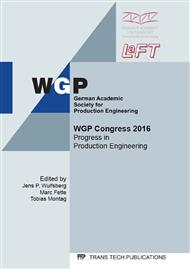[1]
Lutz-Eike, E.: Einsatz elastischer Niederhaltersysteme zur Erweiterung der Prozeßgrenzen beim Tiefziehen. Dr. -Ing. Dissertation, Universität Hannover, (2001).
Google Scholar
[2]
Bräunlich, H.: Blecheinzugsregelung beim Tiefziehen mit Niederhalter – ein Beitrag zur Erhöhung der Prozessstabilität. Dr. -Ing. Dissertation, Technische Universität Chemnitz, (2002).
Google Scholar
[3]
Thoms, V.: Anpassung der Werkzeugsysteme zur Blechumformung an die Umformmaschine. Blech Rohre Profile, Jahrgang 40, Heft 5 1993, S. 375ff.
Google Scholar
[4]
Neugebauer, R.; Hoffmann, M.; Roscher, H. -J.; Scheffler, S; Wolf, K.: Control of sheet-metal forming processes with piezoactuators in smart structures. Proc. SPIE6171, Industrial and Commercial Applications of Smart Structures Technologies, 61710E, (2006).
DOI: 10.1117/12.657387
Google Scholar
[5]
Neugebauer, R.; Mainda, P.; Drossel, W.G.; Kerschner, M.; Wolf, K.: Integrated piezoelectric actuators in deep drawing tools. Proc. SPIE7979, Industrial and Commercial Applications of Smart Structures Technologies, 79790F, (2011).
DOI: 10.1117/12.879888
Google Scholar
[6]
Faaß, I.: Prozessregelung für die Fertigung von Karosserieteilen in Presswerken. Dissertation, Technische Universität München, (2009).
Google Scholar
[7]
Mork, R.: Qualitätsbewertung und –regelung für die Fertigung von Karosserieteilen in Presswerken auf Basis Neuronaler Netze, Dissertation, Technische Universität München, (2011).
Google Scholar
[8]
Thoms, V.; Schatz, M.: Regelung des Werkstoffflusses in Niederhaltersystemen von Zieh- und Nachformwerkzeugen durch Piezoaktoren. Forschungsbericht Nr. 278 Europäische Forschungsgesellschaft für Blechverarbeitung e.V., (2008).
Google Scholar
[9]
Neumann, A.: Konzept zur Beherrschung der Prozessschwankungen im Presswerk. Dr. -Ing. Dissertation, Universität Erlangen, (2013).
Google Scholar
[10]
Siegert, K.; Liewald, M.: Robuster Tiefziehprozess durch Ziehsickenstabhöhenregelung. Düsseldorf: Springer-VDI-Verlag: wt Werkstattstechnik online Heft 10, S. 781-791, (2007).
DOI: 10.37544/1436-4980-2007-10-781
Google Scholar
[11]
Häussermann, M.: Zur Gestaltung von Tiefziehwerkzeugen, Dr. -Ing. Dissertation, Universität Stuttgart, IFU, (2002).
Google Scholar
[12]
Hengelhaupt, J.; Vulcan, M.: Task 1b: Robust Deep Drawing Process of an Experimental Part. Bericht, Department of Energy, USA, (2006).
Google Scholar
[13]
Beck, S.: Optimierung der Zargenspannung beim Ziehen unregelmäßiger Blechformteile. Dr. -Ing. Dissertation, Universität Stuttgart, IFU, (2004).
Google Scholar
[14]
Blaich, C.: Robuster Tiefziehprozess durch Erfassung und Optimierung der örtlichen Bauteilqualität, Dr. -Ing. Dissertation, Universität Stuttgart, IFU, (2011).
Google Scholar
[15]
Liewald, M.; Blaich, C.: Approaches for Closed-loop Control and Optimization of Deep Drawing Processes, in: Proceedings of the Ansys Conference and 27 th CAD FEM Users Meeting, Leipzig, (2009).
Google Scholar
[16]
Liewald, M.; Blaich, C.: Approaches for Evaluation of Robustness and Optimization of Deep Drawing Processes, Proceedings of the 9th International Stuttgart Symposium on Automotive and Engine Technology, (2009).
Google Scholar
[17]
Liewald, M.; Wurster, K.; Blaich, C.: New Approaches on Automated Wrinkle Detection in Sheet Metal Components by Forming Simulation, ESA Form, (2011).
DOI: 10.1063/1.3589677
Google Scholar
[18]
Kraft, M., Liewald, M.: Voraussetzungen und Randbedingungen zur Onlineüberwachung des Platineneinlaufs von Karosseriekomponenten für Regeleingriffe in den Tiefziehprozess, (2015).
Google Scholar
[19]
Hishida, Y.; Wagoner, R., H.: Experimental Analysis of Blank Holding Force Control in Sheet Metal Forming, SAE 930285, pp.93-99, (1993).
DOI: 10.4271/930285
Google Scholar
[20]
Doege, E.; Kracke, M.: Vorhersage der Faltenbildung in geneigten Ziehteilzargen mit elementaren Ansätzen. Blech Rohre Profile, S. 54-61, 11/(1998).
Google Scholar


